Exercises (2276)
Extension and flexion of the arm in push-up position (right) ► row 1-arm push up position
Power
Individual work


In the push-up position, hold a dumbbell in one hand (right) with the other hand flat on the floor. In the push-up position, lift the dumbbell/kettlebell by bringing the elbow back towards the body (next to the ribcage). Then lower the weight back to the starting position in the push-up position (alternatively, do not lower the barbell). The movement only takes place in the elbow and shoulder joint, the rest of the body remains stable.
Starting position:
- Push-up position, one hand placed flat on the floor, the other hand resting on the barbell in a neutral grip
- Tension in the torso (no hollow back)
Finishing position:
- Dumbbell/kettlebell resting on/next to the body at approximately chest height
- Elbows of the arm to be trained bent behind the body and shoulder blades actively squeezed together
- Tension in the torso maintained
Variant:
Combine exercise with push-ups (i.e. after each repetition, one push-up is performed).i.e. a push-up is performed after each repetition, which also works the chest and arm extensor muscles)
1 dumbbell/kettlebell
Extension and flexion of the arm in step position (rowing pull) (left) ► row 1-arm
Power
Individual work


In a slight lunge with bent knees, the upper body is tilted forwards and supported with one hand (right) on the (flat) bench, both arms are almost stretched, with the free hand (left) holding the dumbbell/kettlebell (arm pointing towards the floor), bend the free arm (dumbbell/kettlebell towards the stomach, elbow moving backwards and upwards) and return to the starting position.
Starting position:
- Slight lunge with bent knee
- Upper body tilted forwards (back straight) and supported with one hand (arm extended)
- Outstretched free arm holds the weight and points towards the floor
Finishing position:
- Dumbbell/kettlebell pulled up to the upper abdomen (arm bent)
- Elbows brought as far back as possible
Attention:
Always make sure your back is straight (tense your core). The angle of your back and thighs should remain the same throughout the exercise. Pull your elbows back and up (stay close to your body).
1 flat bench
1 dumbbell/kettlebell
Extension and flexion of the arm in step position (rowing pull) (left) ► row 1-arm
Power
Individual work


In a slight lunge with your knees bent, lean your upper body forwards and support yourself with one hand (right) on the vaulting box, both arms are almost straight, with your free hand (left) holding the dumbbell/kettlebell (arm pointing towards the floor), bend your free arm (dumbbell/kettlebell towards your stomach, elbow up and back) and return to the starting position.
Attention:
Always make sure your back is straight (keep your core tensed). The angle of the back and thighs remains unchanged throughout the exercise. Pull your elbows back and up (stay close to your body).
Lighten:
Less weight.
Harden:
More weight/increased load.
1 Swedish box
1 dumbbell/kettlebell
Extension and flexion of the arm in stepping position (rowing pull) (right) ► row 1-arm
Power
Individual work


In a slight lunge with bent knees, the upper body is tilted forwards and supported with one hand (left) on the (flat) bench, both arms are almost stretched, with the free hand (right) holding the dumbbell/kettlebell (arm pointing towards the floor), bend the free arm (dumbbell/kettlebell towards the abdomen, elbow moving backwards and upwards) and return to the starting position.
Starting position:
- Slight lunge with bent knee
- Upper body tilted forwards (back straight) and supported with one hand (arm extended)
- Outstretched free arm holds the weight and points towards the floor
Finishing position:
- Dumbbell/kettlebell pulled up to the upper abdomen (arm bent)
- Elbows brought as far back as possible
Attention:
Always make sure your back is straight (tense your core). The angle of your back and thighs should remain the same throughout the exercise. Pull your elbows back and up (stay close to your body).
1 flat bench
1 dumbbell/kettlebell
Extension and flexion of the arm in stepping position (rowing pull) (right) ► row 1-arm
Power


In a slight lunge with your knees bent, lean your upper body forwards and support yourself with one hand (left) on the vaulting box, both arms are almost straight, with your free hand (right) holding the dumbbell/kettlebell (arm pointing towards the floor), bend your free arm (dumbbell/kettlebell towards your stomach, elbow up and back) and return to the starting position.
Attention:
Always make sure your back is straight (keep your core tensed). The angle of the back and thighs remains unchanged throughout the exercise. Pull your elbows back and up (stay close to your body).
Lighten:
Less weight.
Harden:
More weight/increased load.
1 Swedish box
1 dumbbell/kettlebell
Extension and flexion of the arm in stepping position with back position (rowing pull) (left) ► inverted row 1-arm
Power
Individual work


Progression I:
Set the sling trainer to a short length, take a stepping position facing the sling trainer, hold the handle (neutral grip) with one hand (left) and lean back, support the free (right) hand on the hip, pull the upper body forwards with just one hand and return to the starting position (bend and stretch the arm). Support the movement with your legs (push off with the back leg when lifting the upper body).
Progression II:
Analogue progression I, but choose a stance with parallel feet closer to the attachment point.
Caution:
Keep body tension, do not let hips sag, pull the handle towards you (for all progressions).
Harden:
The more horizontal the starting position, the more challenging the exercise.
1 sling trainer
Extension and flexion of the arm in step position with backward position (rowing pull) (right) ► inverted row 1-arm
Power
Individual work


Progression I:
Set the sling trainer to a short length, take a stepping position facing the sling trainer, hold the handle (neutral grip) with one hand (right) and lean back, support the free (left) hand on the hip, pull the upper body forwards with just one hand and return to the starting position (bend and stretch the arm). Support the movement with your legs (push off with the back leg when lifting the upper body).
Progression II:
Analogue progression I, but choose a stance with parallel feet closer to the attachment point.
Attention:
Keep body tension, do not let hips sag, pull the handle towards you (for all progressions).
Harden:
The more horizontal the starting position, the more challenging the exercise.
1 sling trainer
Extension und Flexion des Armes in Schulterlage (left) ► bench press off-bench
Power
Individual work
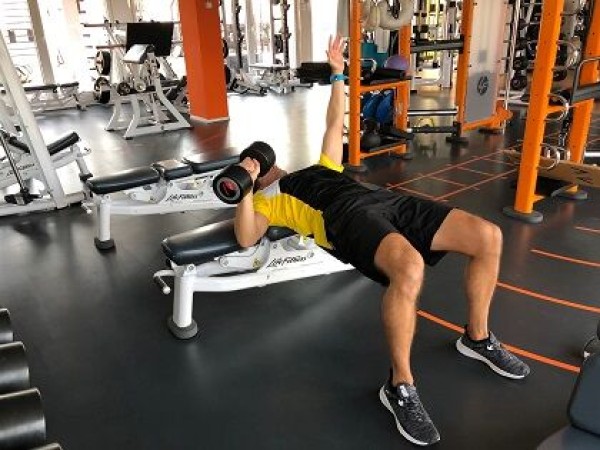
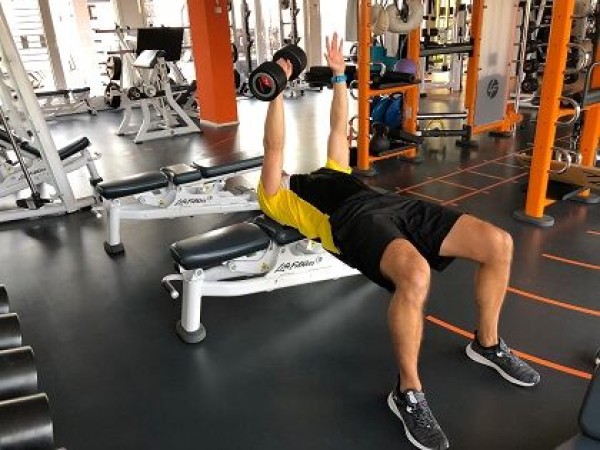
Lying on your back, rest your shoulders on the (flat) bench, keep your hips in the air with your legs bent, both arms in front of you at chest height (arms pointing upwards), holding the dumbbell in one hand (left), lower the training arm until the dumbbell makes (light) contact with your sternum and stretch your arm back to the starting position.
Starting position:
- Lie on your back on the flat bench (only place your shoulders on the bench)
- Legs bent, feet on the floor
- Hips in the air (bring your pelvis upwards)
- Arms at chest height in front of you (pointing upwards in your line of vision)
Finishing position:
- Dumbbell lowered to chest (bend arm)
Attention:
Elbows are always under the wrists, fix wrists, elbows slightly bent away from the torso (A-shape).
Variant:
The exercise can also be performed on an incline bench, whereby the bench should be set at an angle of approximately 45 degrees.
1 flat bench/swinging box
1 dumbbell
Extension und Flexion des Armes in Schulterlage (right) ► bench press off-bench
Power
Individual work


Lying on your back, rest your shoulders on the (flat) bench, keep your hips in the air with your legs bent, both arms in front of you at chest height (arms pointing upwards), holding the dumbbell in one hand (right), lower the training arm until the dumbbell makes (light) contact with your sternum and stretch your arm back to the starting position.
Starting position:
- Lie on your back on the flat bench (only rest your shoulders on the bench)
- Legs bent, feet on the floor
- Hips in the air (bring your pelvis upwards)
- Arms at chest height in front of you (pointing upwards in the direction of your gaze)
Finishing position:
- Dumbbell lowered to chest (bend arm)
Attention:
Elbows are always under the wrists, fix wrists, elbows slightly bent away from the torso (A-shape).
Variation:
The exercise can also be performed on an incline bench, whereby the bench should be set at an angle of approximately 45 degrees.
1 flat bench/swinging box
1 dumbbell
Extension and flexion of the arm with rotation of the upper body while standing (left) ► upper body rotation
Power
Individual work


Stand upright, slightly turned to the side, arms bent and held high (elbows pointing downwards at approximately shoulder height), extend the rear arm (left side) holding the pistol forwards (edge of hand pointing downwards) and simultaneously turn the upper body, then return the upper body and arm to the starting position.
Attention:
Always hold your arms up (shoulder height).
Lighten:
Smaller movements/lower intensity of the punching movement (less rotation when moving with the punching hand).
1 pistol (neutralised)
Extension and flexion of the arm with rotation of the upper body while standing (right) ► upper body rotation
Power
Individual work


Stand upright, slightly turned to the side (left leg in front), arms bent and held high (elbows pointing downwards at approximately shoulder height), extend the rear arm (right side) holding the pistol forwards (edge of hand pointing downwards) and simultaneously turn the upper body, then return the upper body and arm to the starting position.
Attention:
Always hold your arms up (shoulder height).
Lighten:
Smaller movements/lower intensity of the punching movement (less rotation when moving with the punching hand).
1 pistol (neutralised)
Extension and flexion of the leg in lunge (left)
Power
Individual work
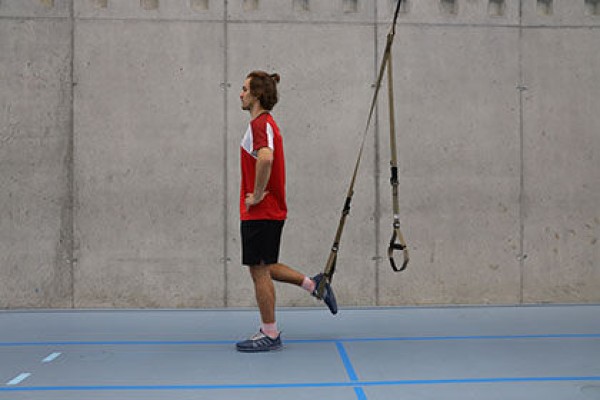

Lunge (left) with the upper body upright, front (left) leg bent (approximately right angle in the knee joint), back (right) leg bent with the foot in the loops, free free free leg (right) backwards and back to the starting position (small short movements).
Attention:
This is a movement with the free leg only, the basic position remains unchanged. The front knee always remains behind the tip of the foot and in the centre above the foot.
Lighten:
Bend the supporting leg less (more upright basic position).
1 sling trainer
Extension and flexion of the leg in lunge (right)
Power
Individual work


Lunge (right) with the upper body upright, front (right) leg bent (approximately right angle in the knee joint), back (left) leg bent with the foot in the loops, free free free leg (left) backwards and back to the starting position (small short movements).
Attention:
This is a movement with the free leg only, the basic position remains unchanged. The front knee always remains behind the tip of the foot and in the centre above the foot.
Lighten:
Bend the supporting leg less (more upright basic position).
1 sling trainer
Extension and flexion of the leg in single-leg stance (left) ► kick back
Power
Individual work


One-legged stand (right) facing the wall bars, hold on to a bar with your hands at chest height, bend your free (left) leg, push your training leg out backwards and return to the starting position.
Attention:
Keep your posture upright.
Lighten:
Less high push-off of the training leg; only hold the end position.
Harden:
Additional weight on the training leg; unstable base for the standing leg.
1 wall bars
1 weight cuff ► to make the exercise more difficult (additional weight)
1 ball/balance cushion/balance board ► to make the exercise more difficult (unstable surface)
Extension and flexion of the leg in single-leg stance (left) ► kick back
Power
Individual work


Stand on one leg (right) on the elastic band (fix the band), slightly bend the upper body forwards, the training leg (left) is slightly bent, the elastic band is wrapped around the foot of the training leg, stretch the training leg backwards and bend back into the starting position.
Attention:
Do not lower the training leg, keep the upper body stable in a slight forward position.
Lighten:
Select an elastic band with less resistance.
Harden:
Select an elastic band with greater resistance.
1 elasticated rubber band
Extension and flexion of the leg in single-leg stance (left) ► leg press
Power
Individual work


Stand on one leg (right), the supporting leg is slightly bent, both loops are hooked onto the raised foot (left) (or only hook the loop on the side of the free leg and the other onto the supporting leg), the knee of the free leg is raised to hip height (thigh horizontal), hold the gymnastics pole with bent parallel forearms in front of the body (baby pose), move the heel of the free leg towards the floor against the resistance of the elastic bands (of the elastic band) and lift it back up to the starting position (stretch and bend the leg).
Lighten:
Select less strong elastic bands; roll up the elastic bands less.
Harden:
Select stronger elastic bands; roll up the elastic bands more.
Variation:
Hold the gymnastic stick on your shoulders behind your head.
1 gymnastic bar with elasticated straps
Extension and flexion of the leg in single-leg stance (left) ► lying leg curl / extension
Power
Partner work
1 trainee & 1 helper ► Note change of position
(= double the time required; for lesson planner see Organisation Kraft: Info button Execution)
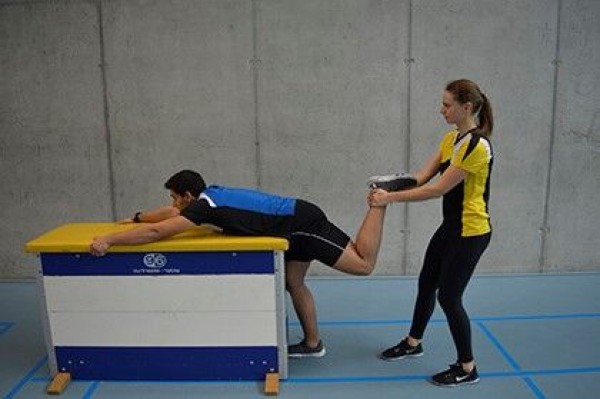
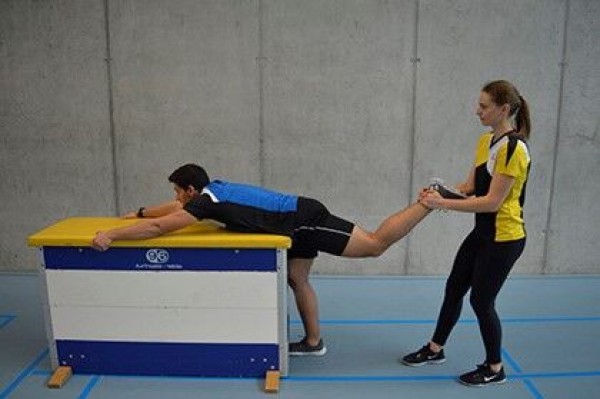
Exerciser: Prone position with the upper body on the top of the box, right leg on the floor, left leg bent (sole of the foot pointing upwards), extend the bent leg backwards and return to the starting position.
Partner: Holds the foot to generate resistance (in both directions).
Attention:
Always listen to/respond to your partner (adjust pressure/intensity). Keep the knee of the training leg in place.
Lighten:
Less resistance from the partner.
Harden:
More resistance from the partner.
1 Swedish box
Extension and flexion of the leg in single-leg stance (right) ► kick back
Power
Individual work


One-legged stand (left) facing the wall bars, hold on to a bar with your hands at chest height, bend your free (right) leg, push your training leg out backwards and return to the starting position.
Attention:
Keep your posture upright.
Lighten:
Less high push-off of the training leg; only hold the end position.
Harden:
Additional weight on the training leg; unstable base for the supporting leg.
1 wall bars
1 weight cuff ► to make the exercise more difficult (additional weight)
1 ball/balance cushion/balance board ► to make the exercise more difficult (unstable surface)
Extension and flexion of the leg in single-leg stance (right) ► kick back
Power
Individual work


Stand on one leg (left) on the elastic band (fix the band), slightly bend the upper body forwards, the training leg (right) is slightly bent, the elastic band is wrapped around the foot of the training leg, stretch the training leg backwards and bend back into the starting position.
Attention:
Do not lower the training leg, keep the upper body stable in a slight forward position.
Lighten:
Select an elastic band with less resistance.
Harden:
Select an elastic band with greater resistance.
1 elasticated rubber band
Extension and flexion of the leg in single-leg stance (right) ► leg press
Power
Individual work


Stand on one leg (left), the supporting leg is slightly bent, both loops are hooked onto the raised foot (right) (or only hook the loop on the side of the free leg and the other onto the supporting leg), the knee of the free leg is raised to hip height (thigh horizontal), hold the gymnastics pole with bent parallel forearms in front of the body (baby pose), move the heel of the free leg towards the floor against the resistance of the elastic bands (of the elastic band) and lift it back up to the starting position (stretch and bend the leg).
Lighten:
Select less strong elastic bands; roll up the elastic bands less.
Harden:
Select stronger elastic bands; roll up the elastic bands more.
Variation:
Hold the gymnastic stick on your shoulders behind your head.
1 gymnastics bar with elasticated straps
Extension and flexion of the leg in single-leg stance (right) ► lying leg curl / extension
Power
Partner work
1 trainee & 1 helper ► Note change of position
(= double the time required; for lesson planner see Organisation Kraft: Info button Execution)


Exerciser: Prone position with the upper body on the top of the vaulting box, left leg on the floor, right leg bent (sole of the foot pointing upwards), extend the bent leg backwards and return to the starting position.
Partner: Holds the foot to generate resistance (in both directions).
Attention:
Always listen to/respond to your partner (adjust pressure/intensity). Keep the knee of the training leg in place.
Lighten:
Less resistance from the partner.
Harden:
More resistance from the partner.
1 Swedish box
Extension and flexion of the leg in the sitting position (left) ► leg extension
Power
Individual work
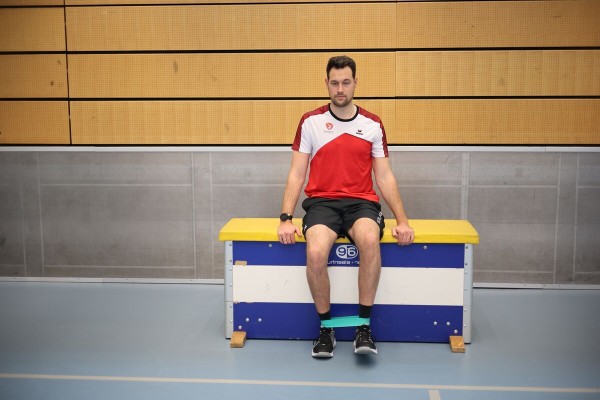

With the upper body upright and one leg (right) on the floor, the other (left) training leg is slightly raised off the floor, stretch an elasticated band between the legs (place the band around the ankles or shins). From this position, stretch the training leg (left) (knee extension - leg pointing forwards) and bend it back to the starting position (lower leg pointing vertically down towards the floor).
Attention:
The movement takes place exclusively in the knee joint (upper body and thigh remain stable).
Lighten:
Choose a rubber band with less resistance.
Harden:
Choose a rubber band with greater resistance.
1 mini-band
1 seating option (e.g. chair, plyo box or vaulting box)
Extension and flexion of the leg in the sitting position (left) ► leg press
Power
Individual work


Sit upright on a long bench/swinging box top/chair, hold the elastic band with both hands at stomach height in front of your body, lift and bend one leg (left) and step into the loop of the elastic band with your foot, extend the training leg forwards and bring it back to the starting position, keeping your arms in place (do not move your arms forwards, counteract the pull of the elastic band).
Attention:
Do not put your training leg down, keep your upper body upright (tense your stomach).
Lighten:
Select an elasticated band with less resistance.
Harden:
Choose a rubber band with greater resistance.
Variant:
The exercise can also be performed lying on your back with your leg slightly raised (bend and straighten your leg).
1 elasticated rubber band
1 long bench/1-2 swivel box elements (incl. top section)/chair
Extension and flexion of the leg in the sitting position (right) ► leg extension
Power
Individual work


With the upper body upright and one leg (left) on the floor, the other (right) training leg is slightly raised off the floor, stretch an elasticated band between the legs (place the band around the ankles or shins). From this position, stretch the training leg (right) (knee extension - leg pointing forwards) and bend it back to the starting position (lower leg pointing vertically down towards the floor).
Attention:
The movement takes place exclusively in the knee joint (upper body and thigh remain stable).
Lighten:
Select a rubber band with less resistance.
Harden:
Select a rubber band with greater resistance.
1 mini-band
1 seating option (e.g. chair, plyo box or vaulting box)
Extension and flexion of the leg in the sitting position (right) ► leg press
Power
Individual work


Sit upright on a long bench/swinging box top/chair, hold the elastic band with both hands at stomach height in front of your body, lift and bend one leg (right) and step into the loop of the elastic band with your foot, extend the training leg forwards and bring it back to the starting position, keeping your arms in place (do not move your arms forwards, counteract the pull of the elastic band).
Attention:
Do not put your training leg down, keep your upper body upright (tense your stomach).
Lighten:
Select an elasticated band with less resistance.
Harden:
Choose a rubber band with greater resistance.
Variant:
The exercise can also be performed lying on your back with your leg slightly raised (bend and straighten your leg).
1 elasticated rubber band
1 long band/1-2 swivel box elements (incl. upper part)/chair